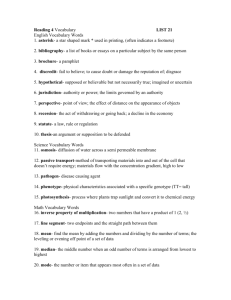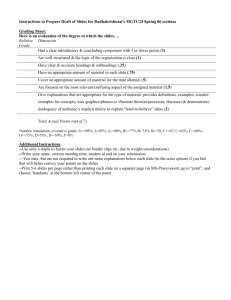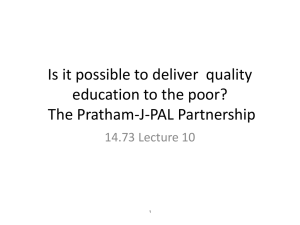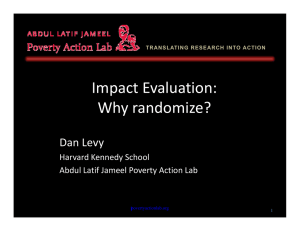14.73 Final Exam Dave Donaldson and Esther Dufo December 16, 2009
advertisement
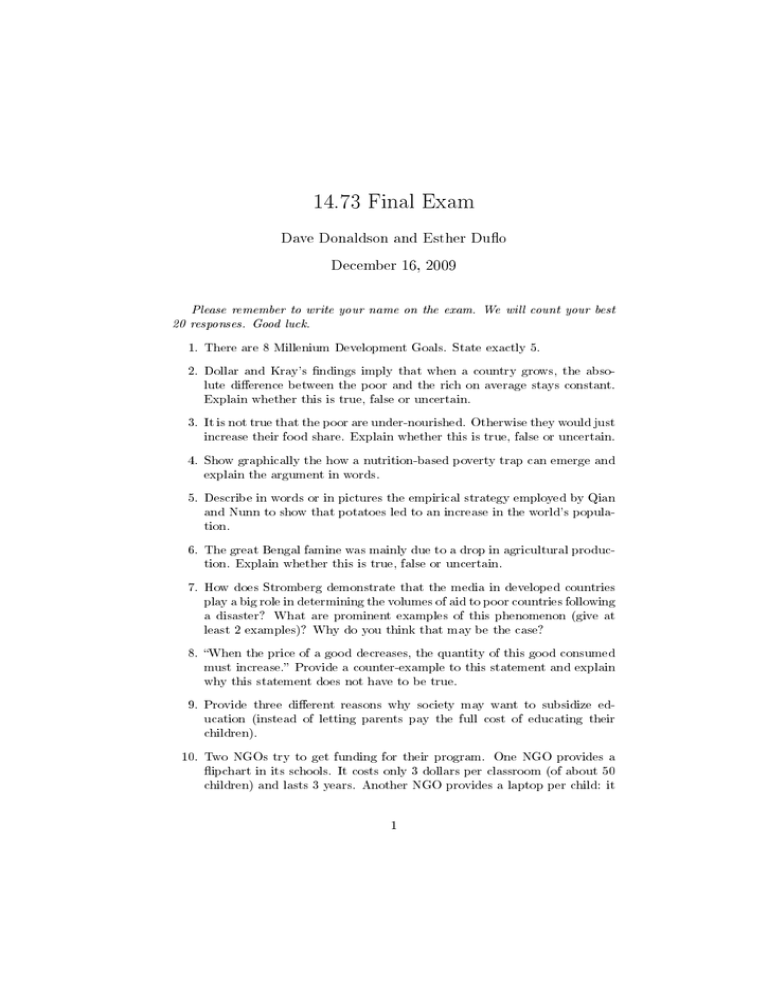
14.73 Final Exam Dave Donaldson and Esther Dufo December 16, 2009 Please remember to write your name on the exam. We will count your best 20 responses. Good luck. 1. There are 8 Millenium Development Goals. State exactly 5. 2. Dollar and Kray's fndings imply that when a country grows, the abso­ lute diference between the poor and the rich on average stays constant. Explain whether this is true, false or uncertain. 3. It is not true that the poor are under­nourished. Otherwise they would just increase their food share. Explain whether this is true, false or uncertain. 4. Show graphically the how a nutrition­based poverty trap can emerge and explain the argument in words. 5. Describe in words or in pictures the empirical strategy employed by Qian and Nunn to show that potatoes led to an increase in the world's popula­ tion. 6. The great Bengal famine was mainly due to a drop in agricultural produc­ tion. Explain whether this is true, false or uncertain. 7. How does Stromberg demonstrate that the media in developed countries play a big role in determining the volumes of aid to poor countries following a disaster? What are prominent examples of this phenomenon (give at least 2 examples)? Why do you think that may be the case? 8. "When the price of a good decreases, the quantity of this good consumed must increase." Provide a counter­example to this statement and explain why this statement does not have to be true. 9. Provide three diferent reasons why society may want to subsidize ed­ ucation (instead of letting parents pay the full cost of educating their children). 10. Two NGOs try to get funding for their program. One NGO provides a fipchart in its schools. It costs only 3 dollars per classroom (of about 50 children) and lasts 3 years. Another NGO provides a laptop per child: it 1 costs 200 per child and is also expected to last for 3 years. A colleague says that the fipchart NGO should be funded because their program is so much cheaper. What evidence do you need to prove or disprove her claim. How will you compare the two NGOs? 11. In Indonesia, Dufo showed that education increased faster between the young and the old cohorts of children who received more schools in their region. She also showed that the wages of the young increased faster compared to the wages of the old in regions that got more schools. What is the assumption that she needs to use the school construction program as an instrumental variable for education when looking at the efect of education on wages? 12. In the Balsakhi experiment, Pratham allocated one Balsakhi per school in all 120 schools in Baroda (Vadodara). How was it nevertheless possible for the researchers to construct a randomized experiment? Explain the design and show which group they compared to which group. What bias can exist in this design? 13. Bleakley claims that childhood exposure to malaria raises the productivity of adults. Outline what you see to be the two most important critiques of this claim. 14. Explain the method of diference­in­diferences (for example, as used in Dufo's study of Indonesian school construction), and explain why this method might be preferred to a simple frst difernce either over two points in time or two points in space. 15. Explain why the intensity with which an owner of an insecticide­treated bednet (ITN) might depend on the price that the owner paid for the bednet. 16. Describe three interventions that might be expected to encourage African farmers' use of fertlizer. Explain whether these interventions are justifed (according to the standard economic approach to government interven­ tions) by the presence of an externality. 17. Banerjee, Dufo, Glennerster and Kinnan studied the entry of Spandana, a microfnance institution, to regions of Hyderabad. Spandana selected 104 regions in which they were prepared to enter, but they entered only a randomly selected 52 of these regions. In the 52 regions that Spandana entered, businesses earned 4810 Rs more in profts on average than busi­ nesses in the other 52 regions. Did the entry of Spandana cause an average business to earn 4810 Rs more in profts? Explain why or why not. 18. Ashraf, Karlan and Yin found that individuals in the Philippines with present­biased (hyperbolic) preferences over intertemporal choices were more likely to take up a commitment savings product. Explain how these authors arrived at this conclusion. 2 19. Moral hazard and adverse selection are two diferent explanations for why insurance is rarely ofered or obtained in developing countries, but these two explanations come down to the same thing. Explain whether this is true, false or uncertain. 20. State two explanations for why better enforcement of property rights may raise incomes, and discuss some of the challenges faced in obtaining em­ pirical evidence that would test these explanations. 21. Acemoglu, Johnson and Robinson present three correlations in the data on ex­colonies: (i) the correlation between good property rights in 1995 and GDP in 1995 is positive; (ii) the correlation between good property rights in 1995 and settler mortality is negative; and (iii), the correlation between GDP in 1995 and settler mortality is negative. Explain how these authors use these three correlations to argue that good property rights in 1995 cause high GDP in 1995. Describe the key assumption that the authors are making and provide one criticism of this assumption. 22. State the main reason, according to Anne Krueger, for the World Bank's creation and compare this to what you see as the principal activity of the World Bank in the past 20 years. (Be sure to defend your choice of the principal activity over the past 20 years.) 23. Explain two reasons why a country might trade with another country. For each of these two reasons, discuss who might beneft (if anyone) and who might lose (if anyone) from this trade. 24. Easterly would describe Jefrey Sachs and Anjelina Jolie as 'transforma­ tionalists' in their perspective on international aid. Explain whether this is true, false or uncertain. 3 MIT OpenCourseWare http://ocw.mit.edu 14.73 The Challenge of World Poverty Spring 2011 For information about citing these materials or our Terms of Use, visit: http://ocw.mit.edu/terms.

